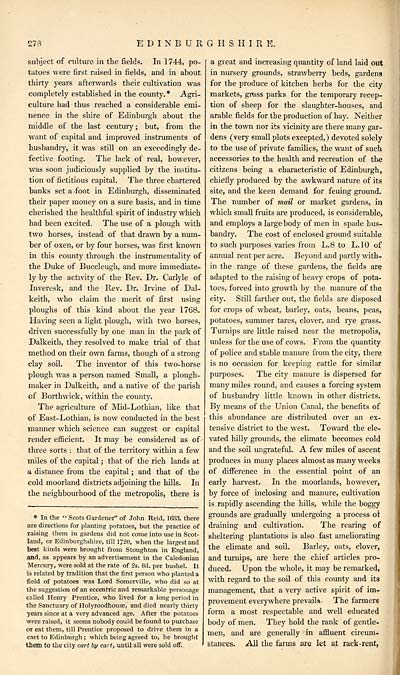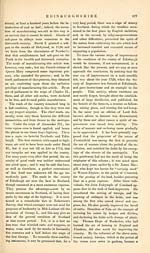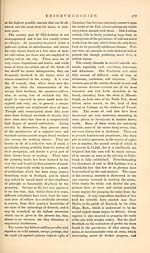Gazetteer of Scotland > Volume 1
(310) Page 278
Download files
Complete book:
Individual page:
Thumbnail gallery: Grid view | List view

273
EDINBURGHSHIRE.
subject of culture in the fields. In 1744, po-
tatoes were first raised in fields, and in about
thirty years afterwards their cultivation was
completely established in the county.* Agri-
culture had thus reached a considerable emi-
nence in the shire of Edinburgh about the
middle of the last century ; but, from the
want of capital and improved instruments of
husbandry, it was still on an exceedingly de-
fective footing. The lack of real, however,
was soon judiciously supplied by the institu-
tion of fictitious capital. The three chartered
banks set a -foot in Edinburgh, disseminated
their paper money on a sure basis, and in time
cherished the healthful spirit of industry which
had been excited. The use of a plough with
two horses, instead of that drawn by a num-
ber of oxen, or by four horses, was first known
in this county through the instrumentality of
the Duke of Buccleugh, and more immediate-
ly by the activity of the Rev. Dr. Carlyle of
Inveresk, and the Rev. Dr. Irvine of Dal-
keith, who claim the merit of first using
ploughs of this kind about the year 1768.
Having seen a light plough, with two horses,
driven successfully by one man in the park of
Dalkeith, they resolved to make trial of that
method on their own farms, though of a strong
clay soil. The inventor of this two-horse
plough was a person named Small, a plough-
maker in Dalkeith, and a native of the parish
of Borthwick, within the county.
The agriculture of Mid-Lothian, like that
of East-Lothian, is now conducted in the best
manner which science can suggest or capital
render efficient. It may be considered as of
three sorts : that of the territory within a few
miles of the capital ; that of the rich lands at
a distance from the capital ; and that of the
cold moorland districts adjoining the hills. In
the neighbourhood of the metropolis, there is
* In the " Scots Gardener" of John Reid, 1683, there
are directions for planting potatoes, but the practice of
raising them in gardens did not come into use in Scot-
land, or Edinburghshire, till 1720, when the largest and
best kinds were brought from Stoughton in England,
and, as appears by an advertisement in the Caledonian
Mercury, were sold at the rate of 2s. 8d. per bushel. It
is related by tradition that the first person who planted a
field of potatoes was Lord Somerville, who did so at
the suggestion of an eccentric and remarkable personage
called Henry Prentice, who lived for a long period in
the Sanctuary of Holyroodhouse, and died nearly thirty
years since at a very advanced age. After the potatoes
were raised, it seems nobody could be found to purchase
or eat them, till Prentice proposed to drive them in a
cart to Edinburgh ; which beirg agreed to, he brought
them to the city cart by cart, until all were sold off.
a great and increasing quantity of land laid out
in nursery grounds, strawberry beds, gardens
for the produce of kitchen herbs for the city
markets, grass parks for the temporary recep-
tion of sheep for the slaughter-houses, and
arable fields for the production of hay. Neither
in the town nor its vicinity are there many gar-
dens (very small plots excepted,) devoted solely
to the use of private families, the want of such
accessories to the health and recreation of the
citizens being a characteristic of Edinburgh,
chiefly produced by the awkward nature of its
site, and the keen demand for feuing ground.
The number of mail or market gardens, in
which small fruits are produced, is considerable,
and employs a large body of men in spade hus-
bandry. The cost of enclosed ground suitable
to such purposes varies from L.8 to L.10 of
annual rent per acre. Beyond and partly with-
in the range of these gardens, the fields are
adapted to the raising of heavy crops of pota-
toes, forced into growth by the manure of the
city. Still farther out, the fields are disposed
for crops of wheat, barley, oats, beans, peas,
potatoes, summer tares, clover, and rye grass.
Turnips are little raised near the metropolis,
unless for the use of cows. From the quantity
of police and stable manure from the city, there
is no occasion for keeping cattle for similar
purposes. The city manure is dispersed for
many miles round, and causes a forcing system
of husbandry little known in other districts.
By means of the Union Canal, the benefits of
this abundance are distributed over an ex-
tensive district to the west. Toward the ele-
vated hilly grounds, the climate becomes cold
and the soil ungrateful. A few miles of ascent
produces in many places almost as many weeks
of difference in the essential point of an
early harvest. In the moorlands, however,
by force of inclosing and manure, cultivation
is rapidly ascending the hills, while the boggy
grounds are gradually undergoing a process of
draining and cultivation. The rearing of
sheltering plantations is also fast ameliorating
the climate and soil. Barley, oats, clover,
and turnips, are here the chief articles pro-
duced. Upon the whole, it may be remarked,
with regard to the soil of this county and its
management, that a very active spirit of im-
provement everywhere prevails. The farmers
form a most respectable and well educated
body of men. They hold the rank of gentle-
men, and are generally in affluent circum-
stances. All the farms are let at rack-rent,
EDINBURGHSHIRE.
subject of culture in the fields. In 1744, po-
tatoes were first raised in fields, and in about
thirty years afterwards their cultivation was
completely established in the county.* Agri-
culture had thus reached a considerable emi-
nence in the shire of Edinburgh about the
middle of the last century ; but, from the
want of capital and improved instruments of
husbandry, it was still on an exceedingly de-
fective footing. The lack of real, however,
was soon judiciously supplied by the institu-
tion of fictitious capital. The three chartered
banks set a -foot in Edinburgh, disseminated
their paper money on a sure basis, and in time
cherished the healthful spirit of industry which
had been excited. The use of a plough with
two horses, instead of that drawn by a num-
ber of oxen, or by four horses, was first known
in this county through the instrumentality of
the Duke of Buccleugh, and more immediate-
ly by the activity of the Rev. Dr. Carlyle of
Inveresk, and the Rev. Dr. Irvine of Dal-
keith, who claim the merit of first using
ploughs of this kind about the year 1768.
Having seen a light plough, with two horses,
driven successfully by one man in the park of
Dalkeith, they resolved to make trial of that
method on their own farms, though of a strong
clay soil. The inventor of this two-horse
plough was a person named Small, a plough-
maker in Dalkeith, and a native of the parish
of Borthwick, within the county.
The agriculture of Mid-Lothian, like that
of East-Lothian, is now conducted in the best
manner which science can suggest or capital
render efficient. It may be considered as of
three sorts : that of the territory within a few
miles of the capital ; that of the rich lands at
a distance from the capital ; and that of the
cold moorland districts adjoining the hills. In
the neighbourhood of the metropolis, there is
* In the " Scots Gardener" of John Reid, 1683, there
are directions for planting potatoes, but the practice of
raising them in gardens did not come into use in Scot-
land, or Edinburghshire, till 1720, when the largest and
best kinds were brought from Stoughton in England,
and, as appears by an advertisement in the Caledonian
Mercury, were sold at the rate of 2s. 8d. per bushel. It
is related by tradition that the first person who planted a
field of potatoes was Lord Somerville, who did so at
the suggestion of an eccentric and remarkable personage
called Henry Prentice, who lived for a long period in
the Sanctuary of Holyroodhouse, and died nearly thirty
years since at a very advanced age. After the potatoes
were raised, it seems nobody could be found to purchase
or eat them, till Prentice proposed to drive them in a
cart to Edinburgh ; which beirg agreed to, he brought
them to the city cart by cart, until all were sold off.
a great and increasing quantity of land laid out
in nursery grounds, strawberry beds, gardens
for the produce of kitchen herbs for the city
markets, grass parks for the temporary recep-
tion of sheep for the slaughter-houses, and
arable fields for the production of hay. Neither
in the town nor its vicinity are there many gar-
dens (very small plots excepted,) devoted solely
to the use of private families, the want of such
accessories to the health and recreation of the
citizens being a characteristic of Edinburgh,
chiefly produced by the awkward nature of its
site, and the keen demand for feuing ground.
The number of mail or market gardens, in
which small fruits are produced, is considerable,
and employs a large body of men in spade hus-
bandry. The cost of enclosed ground suitable
to such purposes varies from L.8 to L.10 of
annual rent per acre. Beyond and partly with-
in the range of these gardens, the fields are
adapted to the raising of heavy crops of pota-
toes, forced into growth by the manure of the
city. Still farther out, the fields are disposed
for crops of wheat, barley, oats, beans, peas,
potatoes, summer tares, clover, and rye grass.
Turnips are little raised near the metropolis,
unless for the use of cows. From the quantity
of police and stable manure from the city, there
is no occasion for keeping cattle for similar
purposes. The city manure is dispersed for
many miles round, and causes a forcing system
of husbandry little known in other districts.
By means of the Union Canal, the benefits of
this abundance are distributed over an ex-
tensive district to the west. Toward the ele-
vated hilly grounds, the climate becomes cold
and the soil ungrateful. A few miles of ascent
produces in many places almost as many weeks
of difference in the essential point of an
early harvest. In the moorlands, however,
by force of inclosing and manure, cultivation
is rapidly ascending the hills, while the boggy
grounds are gradually undergoing a process of
draining and cultivation. The rearing of
sheltering plantations is also fast ameliorating
the climate and soil. Barley, oats, clover,
and turnips, are here the chief articles pro-
duced. Upon the whole, it may be remarked,
with regard to the soil of this county and its
management, that a very active spirit of im-
provement everywhere prevails. The farmers
form a most respectable and well educated
body of men. They hold the rank of gentle-
men, and are generally in affluent circum-
stances. All the farms are let at rack-rent,
Set display mode to: Large image | Transcription
Images and transcriptions on this page, including medium image downloads, may be used under the Creative Commons Attribution 4.0 International Licence unless otherwise stated. ![]()
| Gazetteers of Scotland, 1803-1901 > Gazetteer of Scotland > Volume 1 > (310) Page 278 |
|---|
| Permanent URL | https://digital.nls.uk/97428082 |
|---|
| Description | Volume I: Abbey to Glenartney. |
|---|---|
| Attribution and copyright: |
|
| Description | By Robert Chambers and William Chambers. Glasgow: Blackie & Son, 1838. 2 volumes. |
|---|---|
| Shelfmark | NF.1461.g.7 |
| Additional NLS resources: | |

